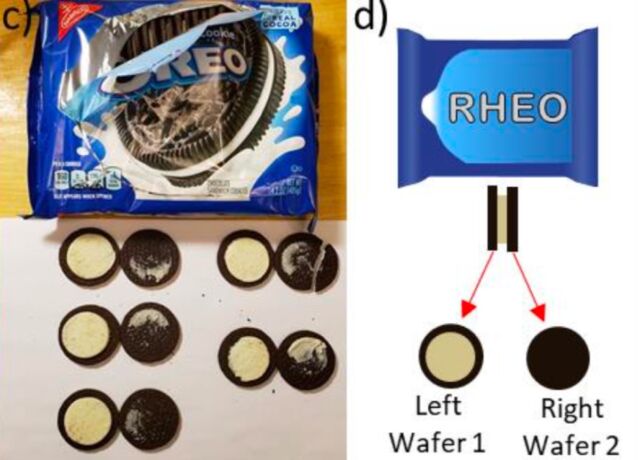“Oreology” investigates mystery of why Oreo creme filling usually sticks to one side
Everyone has their preferred method for snacking on tasty Oreo cookies: twisting the two halves apart to eat the creme filling first, perhaps, before dunking the chocolate wafers in a glass of milk. But you may have noticed that the creme typically sticks to only one chocolate wafer. MIT scientists tried to get to the bottom of why this is so often the case in a paper published in the journal Physics of Fluids. The authors playfully invoked a new scientific subfield they dubbed “oreology” (“Oreo” after the classic Nabisco cookie, “logy” from the Greek for “flow study,” rheo logia).
Co-author Crystal Owens, a graduate student at MIT, doesn’t study foods in particular; her primary focus is on 3D printing with complex fluid inks. “But great examples of complex fluids are all around us—many foods, sauces, condiments, yogurt, ice cream, and other products,” she told Ars. “So it’s natural and convenient to find foods to test our theories.” Early on in her Phd thesis research, Owens designed a novel rheology tool and tested it on hair gel and mayonnaise to make sure it would work with everyday materials.
There is rich scientific literature on what Owens calls “kitchen relevant flows.” For example, scientists have studied the structure of cheese; investigated the composition and flow of gluten-free batter and breads; discovered why strands of honey can get so long and thin as they drip without actually breaking; figured out a way to get cocoa butter to distribute more evenly in chocolate to enhance the perceived texture; studied why Brazil nuts rise to the top of a can of mixed nuts (aka the “Brazil nut effect“); and figured out how to “tune” the flow of Swiss cheese fondue by adding cornflour or wine.

As for the Oreo question, Owens credits her “latent childhood curiosities” as inspiration. She was always keen to discover the best way to twist open an Oreo to get at the tasty creme inside. “Eating a wafer with creme has a different taste than when the creme is between wafers,” she said. “I tried especially to split it evenly between wafers so there’s some covering both halves, which in my opinion tastes much better than having one wafer with creme and one with almost none.” But that feat proved difficult to achieve using just her hands.
Early in her MIT graduate studies, Owens was studying yield stress fluids made of carbon nanotubes on the lab’s rheometer, an instrument used to characterize the flow of a substance in response to forces (i.e., its rheology). The rheometer twists the fluid between parallel disks in order to measure its viscosity. “I realized I had the right knowledge and the right tools to study the Oreo breakage rigorously using our laboratory equipment,” she said. “So I proposed the idea to my research adviser, and the project was born.”
Oreos happen to be a “canonical example of parallel plate rheometry,” Owens et al. wrote in their paper, describing the cookies as an “everyday trilayer laminate composite.” The creme is the fluid sample, and the two wafers are the parallel plates. Counter-rotating the wafers causes the creme to shear and flow before fracturing, as the two wafers come apart.

Owens and her co-authors bought the Oreos for their experiments at a local grocery store. They made sure to purchase regular, Double Stuf, and Mega Stuf varieties to test different creme levels, as well as Golden, Dark Chocolate, and Team USA Olympic varieties to test different flavors. Once in the lab, they attached each cookie to the rheometer’s parallel plates with a glue gun, excluding any broken cookies. Then they rotated one wafer relative to the other and checked to see how much creme ended up on each wafer.
“I had in my mind that if you twist the Oreos perfectly, you should split the creme perfectly in the middle,” said Owens. “But what actually happens is the creme almost always comes off of one side.” The experiments showed that this creme distribution is not affected by rotation rate, the amount of creme filling, or the flavor. Rather, the pre-existing level of adhesion between the creme and the chocolate wafers seemed to be the determining factor. Cookies from the package within any one box typically separated with the same preferred orientation most of the time. This suggests that it has something to do with how the cookies are manufactured and then oriented during packaging, as well as how they are stored.
However, the rotation rate does play an important role in whether or not the cookies break apart cleanly. “If you try to twist the Oreos faster, it will actually take more strain and more stress to break them,” said Owens. “So, maybe this is a lesson for people who are stressed and desperate to open their cookies. It’ll be easier if you do it a little bit slower.”
https://arstechnica.com/?p=1848644